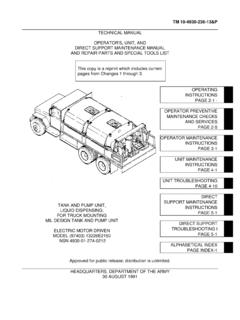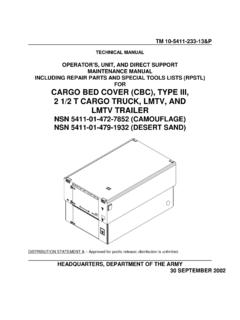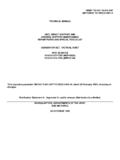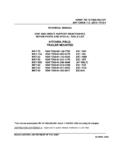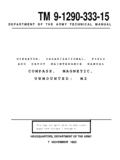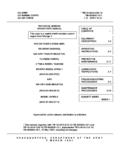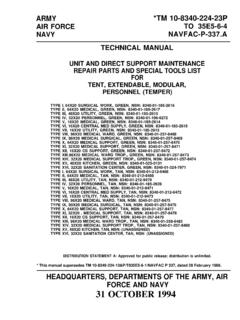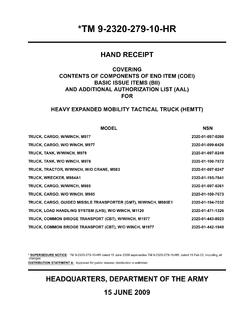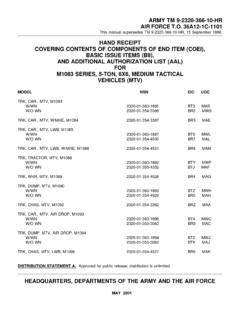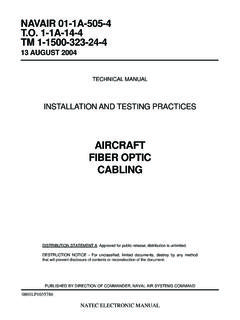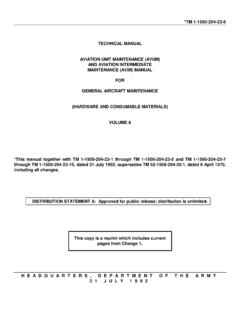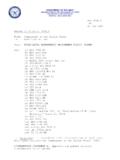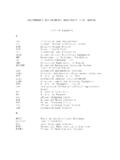Transcription of *TM 1-1500-204-23-9 AND AVIATION …
1 *TM 1-1500-204-23-9 . TECHNICAL manual . AVIATION unit maintenance (AVUM). AND AVIATION intermediate . maintenance (AVIM) manual . FOR. GENERAL AIRCRAFT maintenance . (TOOLS AND GROUND SUPPORT EQUIPMENT). VOLUME 9. *This manual together with TM 1-1500-204-23-1 through TM 1-1500-204-23-8 and TM 1-1500- 204-23-10, dated 31 July 1992, supersedes TM 55-1500-204-25/1, dated 6 April 1970, including all changes. DISTRIBUTION STATEMENT A: Approved for public release; distribution is unlimited. HEADQUARTERS, DEPARTMENT OF THE ARMY. 31 JULY 1992. TM 1-1500-204-23-9 . PRECAUTIONARY DATA. Personnel performing instructions involving operations, procedures, and practices which are included or implied in this technical manual shall observe the following instructions. Disregard of these warnings and precautionary information can cause serious injury, death, or an aborted mission.
2 HAZARD COMMUNICATION. Most materials supplies listed in this volume (paints, solvents, etc.) contain chemical agents which are considered hazardous under 29 CFR , The Hazard Communication Rule (25 Nov 1983). All personnel who have potential on-the-job exposure to chemical agents must be aware of provisions of their organization's written hazard communications program which describes how your facility will comply with the standard. An important part of this standard is the requirement for Material Safety Data Sheets (MSDS) for hazardous materials. The MSDS lists the hazardous chemical components for the product and contains essential information on use, handling, fire-fighting, labelling, emergency procedures (such as accidental spills and leaks) and disposal of material. These MSDS must be accessible to the worker and adequate training provided BEFORE use of hazardous materials.
3 MSDS by them- selves are not an adequate substitute for proper training and written procedures. Consult your supervisor, safety officer or industrial hygienist before using any material which may be considered hazardous. Warning labels on products or general warnings mentioned in this document ARE NOT intended to be a complete description of all potential hazards, nor are they a substitute proper training and MSDS information. WARNINGS, CAUTIONS, AND NOTES are means of attracting attention to essential or critical information in a manual . are outlined as follows: WARNING: An operating or maintenance procedure, practice, condition, statement, etc. which if not strictly ob- served, could result in injury to or death of personnel. CAUTION: An operating or maintenance procedure, practice, condition, statement, etc., which, if not strictly ob- served could result in damage to, or destruction of, equipment or loss of mission effectiveness or long term health hazards to personnel.
4 NOTE: An essential operating or maintenance procedure, condition, or statement, which must be highlighted. a TM 1-1500-204-23-9 . USING SOLVENTS/PAINTS. Consider all solvents/paints potentially hazardous and .ammable. Consult MSDS and be thoroughly familiar with health and safety aspects of material prior to use. HOT BRAKES. If it is necessary to approach a wheel with a hot brake, do so either from directly in front or directly behind the aircraft. GROUND SUPPORT EQUIPMENT. To prevent accidental falls, appropriate maintenance platforms/safety stands illustrated in appropriate workstand manuals or any other approved locally procured/manufactured safety stands/restraint equipment will be used when working (above 4 feet) on aircraft in a non-tactical environment. Do not attempt to lift any load when the hydraulic axle jack is tilted.
5 Release air pressure in air compressor tank before performing maintenance on air compressors. Disconnect power before changing belts on electrically-driven compressors. Disconnect electrical power before opening or disassembling any part of electrical equipment. Install safety lock when an adjustable-height maintenance platform is in use. Ensure the air hose used with compressed air is safe for the pressure being handled. FIRE EXTINGUISHERS. Halon type .re extinguishers, Monobromotrifluoromethane (CF3BR) and Bromocholormethane (CB) are odorless gasses. When used in confined areas, available oxygen for breathing may be depleted. Use supplied breathing air when using these gasses in enclosed spaces. HYDRAULIC FLUID. To avoid contamination, do not use previously opened cans of hydraulic fluid. Cans of hydraulic fluid can not be re- sealed.
6 Immediately transfer unused hydraulic fluid to an approved airtight, pressure venting, stainless steel storage reservoir, an approved hydraulic servicing unit or a hydraulic test stand containing the same hydraulic fluid. When opening can, clean top and use a clean sharp, unplated instrument to prevent contamination. Can openers attached to the aircraft must be cleaned before using. COMPRESSED AIR. Compressed air shall not be used for cleaning purposes unless reduced to less than 30 psi and then only with effective chip-guarding and personal protective equipment. NOISE HAZARD. Noise levels reached during ground runup of Army aircraft are of a level that may cause permanent hearing loss. All personnel shall wear adequate hearing protection when working on aircraft with engines in operation. b Change 5. TM 1-1500-204-23-9 . PROPER USE OF PLATED TOOLS.
7 Use only chrome plated steel or unplated steel tools for disassembly or reassembly procedures described in this manual . Use of cadmium or zinc plated tools is not permitted since these platings are prone to chipping and flaking. Should these chips or flakes become embedded in aircraft parts, galvanic corrosion will result. Should these chips or flakes enter fuel or oil wetted components, they may eventually clog the filter or produce intergranular attack of nickel or titanium base alloys at elevated temperature. All tools regardless of type plating should be serviceable and free of chipping. ELECTRICAL EQUIPMENT. All switches and electrical equipment shall be of the enclosed explosion-proof type. All metal apparatus shall be grounded to avoid the danger of igniting test fluid fumes or creating electrical shock. LUBRICATING OIL.
8 Lubricating oil, MIL-L-7808 or MIL-L-23699, contains an additive which is poisonous and absorbed readily through the skin. Do not allow oil to remain on skin any longer than necessary. To avoid contamination, do not use previously opened cans of turbine engine oil. A new sealed can of fluid must be opened and used. When opening can, clean top and use a clean sharp, unplated instrument to prevent contamina- tion. FUEL. When servicing aircraft or support equipment, clean up spilled fuel with cotton mops or cotton rags. Wash off any fuel on hands, body, or clothing. HANDLING ACID. Wear protective clothing when mixing acid with water. Always pour acid into water, never water into acid. REMOVING CORROSION. Take precautions to prevent possible dust explosions when removing corrosion from steel alloys. Use goggles or face shield when removing paint or corrosion with a wire brush or by the grinding method.
9 OXYGEN SYSTEM. Do not allow petroleum base products to come in contact with oxygen system components, as an explosion or fire may result. Change 5 c TM 1-1500-204-23-9 . CLEANING COMPOUND, MIL-PRF-87937 TYPE II. Cleaning compound can irritate eyes and skin. Wear protective gloves and goggles. Avoid repeated or prolonged contact. DEGREASING SOLVENT, MIL-PRF-680. Degreasing Solvent, MIL-PRF-680, is combustible and toxic to eyes, skin, and respiratory tract. Wear protective gloves and goggles/face shield. Avoid repeated or prolonged contact. Use only in well-ventilated areas (or use approved respirator as determined by local safety/industrial hygiene personnel). Keep away from open flames or other sources of ignition. HFE-71DE. HFE-71DE is toxic to eyes, skin, and respiratory tract, and decomposes into other hazardous products to extreme heat.
10 Wear chemical protective gloves and goggles/face shield. Avoid repeated or prolonged contact. Use only in well-ventilated areas. If ventilation is not adequate, use approved respirator as determined by local safety/industrial hygiene personnel. Keep away from open flames, welding, or other sources of extreme heat. ALIPHATIC NAPHTHA. Aliphatic Naphtha is extremely flammable and toxic to eyes, skin, and respiratory tract. Wear protective gloves and goggles/face shield. Avoid repeated or prolonged contact. Use only in well-ventilated areas (or use approved respirator as determined by local safety/industrial hygiene personnel). Keep away from open flames, sparks, or other sources of ignition. d Change 5. TM 1-1500-204-23-9 . C5. CHANGE HEADQUARTERS. DEPARTMENT OF THE ARMY. NO. 5 WASHINGTON, , 13 January 2011. AVIATION unit maintenance (AVUM) AND AVIATION intermediate .
